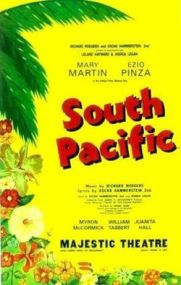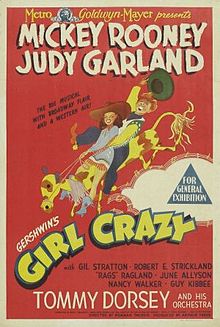South Pacific
 South Pacific Broadway Poster (1949)
South Pacific Broadway Poster (1949)
Composer: Richard Rodgers
Lyricalist: Oscar Hammerstein II
Book writer: Oscar Hammerstein II and Joshua Logan
First show:
1949 Broadway – Majestic Theatre
1950 U.S. tour
1951 West End
1988 West End revival
2001 West End revival
2007 U.K. tour
2008 Broadway revival
2009 U.S. tour
Awards:
1950 Original Broadway Production
Pulitzer Prize – 1950 (Won)
(X10) Tony Award – 1950 (Won)
2001 London Revival
Laurence Olivier Award – 2001 (Won)
2001 Television Film
Emmy Award – 2001 (Nominated)
2008 Broadway Revival
Drama Desk Award – 2008 (Won 5/8) (Nominated 3/8)
Outer Circle Award – 2008 (Won 5/8) (Nominated 3/8)
Tony Award – 2008 (Won 7/11) Nominated 4/11)
2011 London Revival
Laurence Olivier Award – 2012 (Nominated 3/3)
Based from anything? Based off Pulitzer Prize winning novel by James A. Michener “Tales of The South Pacific”
Main Character:
Emile De Becque – Middle age, French planter, love interest for Nellie.
Nellie Forbush – US Navy nurse, love interest for Emile.
Other Characters:
Lieutenant Joseph Cable – young, marine officer
Liat – Young, Tonkinese Women
Bloody Mary – mother of Liat, Island wheeler-dealer
Seabee Luther Billis – entrepreneurial Sailor
Ngana – Emile’s daughter
Jerome – Emile’s son
Captain George Brackett – Military captain of the island
Commander William Harbinson – Brackett’s executive officer
Synopsis:
Act 1: Set on a South Pacific Island during the World War II. A simple love story between Emile and Nellie starts to form. Meanwhile the captain George and commander William think about asking Nellie to find out more about Emile. Nellie then finds out about Emile’s mix raced children and tells the nurses that she is going to end their ongoing relationship.
Act 2: With illness breaking out war goes ahead vs Japan. Also during this time another racial bound relationship forms with Liat and Cable However Cable is undecided due to his parent’s view on people’s race. In the end Mary speaks him through and he is okay with idea. Emile then proposes she realizes it really does not matter and how much politics doesn’t matter. Later on once the war is successful Emile’s children start to even grow and Nellie begins to love the Jerome and Ngana.
Popular Musical Numbers:
“I’m Gonna Wash That Man Outta My Hair” (1958 Movie Ver.) – Solo female song and backing girls and is sung by Nellie. This song is quite a comedic song and is written about Nellie wanting to leave Emile and tell the girls about it. However it has a strangely upbeat nature to it for a song about a topic such as love. I think this is memorable song as it’s a very consistent beat and quite cheery so it’s easy to remember or get stuck in your head.
“Bali Ha’I” (1958 Movie Ver.) – Solo female song and is sung by Bloody Mary. A song all about leaving to Bali Ha’I and taking your dreams an ambitions there and coming to the special island which calls you. Overall a more relaxing song and from the version I watched some very powerful voices to add to the song and not let it sound boring vocal wise.
“Some Enchanted Evening” (1958 Movie Ver.) – Solo male song and is sung by Emile. This song sounds as though the male singer is attempting to woo the women and saying about love and how you shouldn’t let go.
“There Is Nothing Like a Dame” (2001 Movie Ver.) – Group song. Another cheery upbeat song with memorable lyrics. A comedic piece about how a dame is like no other and how they have everything else but a dame.
“Happy Talk” (1958 Movie Ver.) – Female solo song and is sung by Bloody Mary. Bloody Mary is singing about Liats and Cables dreams and refers to their possible relationship. It is a very over romantic song and is very cutesy.
“Younger Than Springtime” (1958 Movie Ver.) – Male solo song and is sung by Cable. Similar to ‘Some Enchanted Evening’ although this song has more strong music and can be heard with ease a lot more. The song is very calming and powerful. Near the end even has a slight backing from girls which almost makes it sound spooky and ominous.
“I’m in Love with a Wonderful Guy” (1958 Movie Ver.) – Female solo song and is sung by Nellie. This song is more of a powerful love song compared to the rest she uses all sorts of resemblances such as ‘Corny as Kansus in August’ This is sang just after ‘I’m Gonna Wash That Man Outta My Hair’ And is basically her saying her true feeling towards Emile and how he is a wonderful guy.
How was the musical received?
The original Broadway production was well received and even has the title of the second longest running Broadway musical at the time behind “Oklahoma!” The show is also said to keep its popularity even now, the musical also sends out a strong message about racism.
Relevant?
I personally think this show can be used as a good production in college as it covers some important messages such as racism. Racism is still a big issue and sadly probably will be through out however the message of this show is that race and religion does not affect who you speak to and shouldn’t mean you cannot mix with other people because of these reasons.
Girl Crazy
 Girl Crazy Film Poster (1942)
Girl Crazy Film Poster (1942)
Composer: George Gershwin
Lyricalist: Ira Gershwin
Book writer: Guy Boltan and John McGowen
Choreographer: George Hale
Set Design: Donald Oenslager
First show:
1930 Broadway (Alvin Theatre)
1932 Film
1943 Film
Main Character:
Danny Churchill – Running after girls, He eventually has a love interest for Molly Grey.
Molly Grey – Local Postmistress and love interest of Danny Churchill.
Other Characters:
Tess Parker
Sam Mason
Flora James
Gilbert Goldfarb
Lariat Joe
Slick Fothergill
Lank Sanders
Kate Fothergill
Patsy West
Jake Howell
Pete
Synopsis:
Danny Churchill Jr. father sends him away as he feels Danny is too focused on parties and girls. He then moves to Custerville, Arizona to work at his family’s ranch. He then changes the ranch into a dude ranch moving show girls from Broadway and hiring people to come. Although after a while he falls in love with a local postmistress Molly Grey. Eventually they actually win each other’s affection. Although there is a slight problem with a New York rival.
Some Musical Numbers:
But Not For Me (1941 Film Ver.) – A female solo song, Sang by Molly Grey.
This song is basically about how love is happening but not for her. We know this from lines such as ‘When every happy plot, Ends in a marriage plot, and there’s no knot for me.
Boy What Love Has Done To Me! (1942 Film Ver.) – A female solo song, Sang by Ethel Merman.
From this song it sounds as though she is fed up of being a stereotypical housewife and if wondering if she should leave although she does not know where she should go or what would even happen.
*Note I struggled to find songs that are popular in this musical so I decided to link to a couple of random songs in Girl Crazy.
How was the musical received?
Not a huge amount is written from a slight research however it a sounds as though they are very positive one even referred to it as fresh and ingenious.
Closed on June 6 1931 after 272 performances.
‘Crazy for You’ Musical was actually based off Girl Crazy and even features songs from Girl Crazy.
Relevant?
Slightly less relevant compared to ‘South Pacific’ however it is still a show with a important message. This show would have the message of there is more to life than fun drugs etc. Of course the target audience of this show would be a lot more teen to early adult however both have target audiences in my opinion which should have later target audiences.